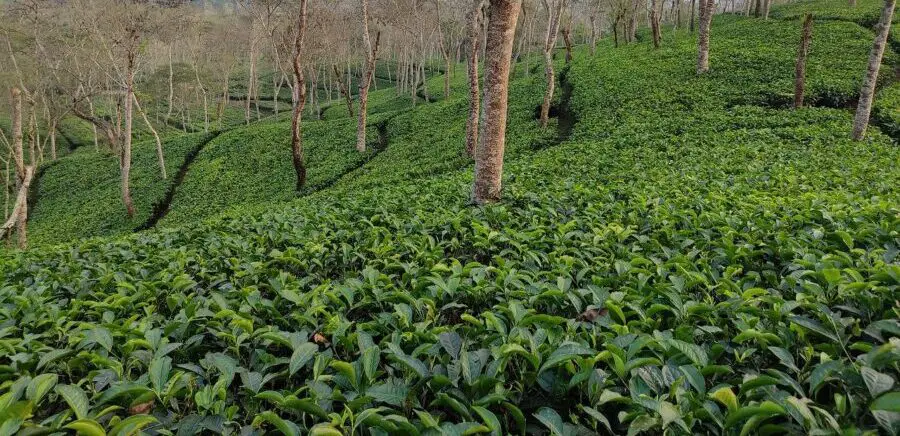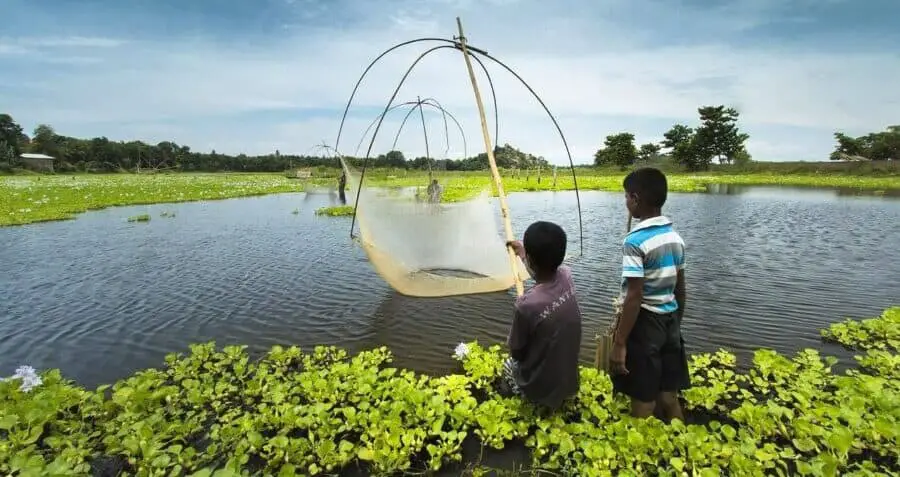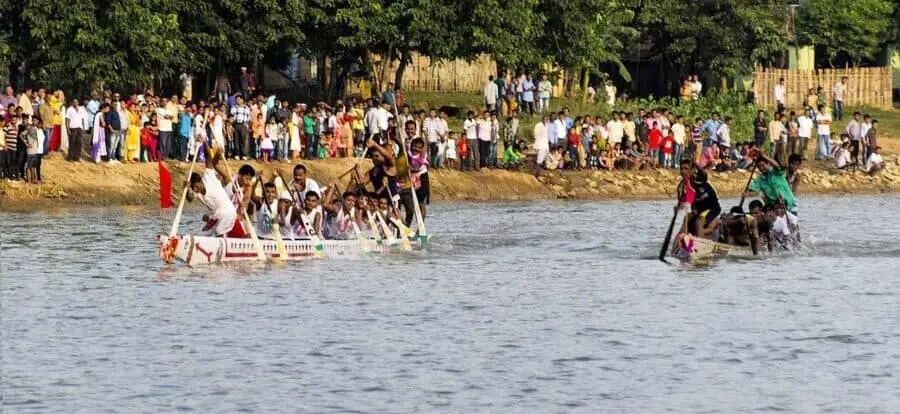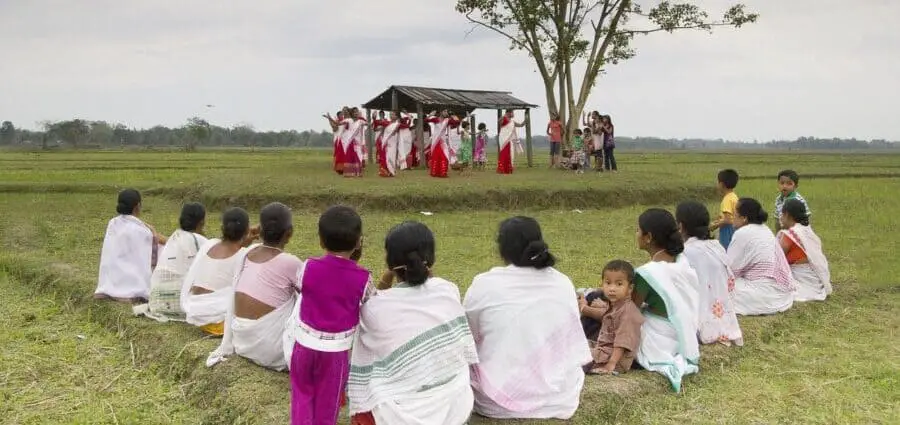What makes Assam famous? Well, imagine you’re sitting at home, cozy and comfortable, and suddenly, the rain starts to pour outside. It’s a scene straight out of a dream, isn’t it? But here’s the twist – even in the comfort of your home, you find yourself craving something. Except for ROMANCE. IT WOULD BE TEA!!! Wouldn’t it be???
Let’s delve into the essence of Assam, beyond its renowned tea plantations. Assam isn’t just about tea; it’s a treasure trove waiting to be explored. Amidst its verdant landscapes lies the allure of Assam Silk, a testament to its rich cultural heritage. Today, let’s embark on a journey through Assam, setting aside logistical details to savor its essence.
Assam, a land steeped in history and tradition, beckons with its vibrant culture. From its mesmerizing dance forms to its elaborate festivals, Assam offers a tapestry of experiences. Delve into the intricacies of Assamese architecture, witness the grandeur of its historical monuments, and immerse yourself in the rhythms of its traditional crafts.
This article invites you to discover Assam beyond the ordinary, to uncover its soul through its diverse cultural tapestry. Join us as we traverse through the realms of Assamese culture, history, and tradition, inviting you to ponder whether this captivating land is worthy of your exploration.
As you step onto the fertile soil of Assam, the sprawling plains unfold before you, adorned with lush greenery stretching as far as the eye can behold. Here, amidst the verdant landscape, nature thrives in abundance, teeming with diverse wildlife and rich natural resources that embellish both urban centers and rural towns.
Welcome to Assam, a northeastern gem of India, nestled amidst the southern slopes of the majestic Himalayas, cradled between the valleys of the mighty Brahmaputra and Barak rivers. This state, a vibrant tapestry of modernization and tradition, showcases a delicate dance between progress and heritage, as it seeks to strike a harmonious balance between the two.
Within its borders, Assam hosts a substantial population, bustling with life and diversity, reflecting the dynamic spirit of its people.
Also, Checkout Delhi to Nainital Complete Trip Itinerary
WHAT IS ASSAM FAMOUS FOR?
Blog Post Content
As I have mentioned earlier it is famous for ASSAM TEA, but there are many more things that make it famous which are one-horned rhinoceros, traditional silk (Eri silk, Muga silk, and Mulberry silk), this state is the land of two world heritage sites and not to forget its wildlife which provides one of the last wild habitats for the Asian elephant.
TEA GARDEN/ CULTIVATION

Assam is the largest tea producer in India. It contributes over 52% of the total tea production of India. This makes India the largest tea producer in the world. Assam owns more than 800 tea estates and 90000 small tea gardens. Dibrugarh plays a huge role in this.
Monabarie Tea Estate
It is located in the Sonitpur district of the state of Assam. It is the largest tea estate in Assam. To your wonder, it is the largest tea state in Asia too.
Dibrugarh: It is known as the tea city of India. It lies in the upper part of Assam. It is also known as the tea capital of Assam.
ONE HORNED RHINOCEROS: It is an endangered species. It is also known as Indian Rhinoceros.
BHOOT JOLOKIA
It literally translates into ghost chilly. It is also known as red naga chili. It is one of the hottest chilies in the world. It is majorly cultivated in Assam, Nagaland, and Manipur. This is used in cuisine and food here like pickles, fish curry, chili sauce, etc. It is this hotter that it can cause death to a person if he eats a kg of it. It is 400 times hotter than the Jalapeno pepper. The chili powder is widely used in the preparation of grenades during defense, after exploding, it creates dense smoke which causes skin burns and rashes. Yeah, it is this danger. Now, do you know what else is Assam famous for?
Also, Checkout Delhi to Kedarnath Complete Trip Itinerary
Wildlife In Assam
There are still many more reasons to fall in love with this place. It has 2 tiger reserves, 5 elephant reserves, 2 biosphere reserves, it has about 300 reserved forests covering around 13000 sq. km. and there are about 40-50 important bio-diversities.
BRAHMPUTRA RIVER

the only male river of the nation. It divides Assam into the North and south parts. It is the main source of water in the state. It originates in Tibet and enters India from Arunachal Pradesh. Its importance can’t be denied when it comes to irrigation, hydroelectricity generation, etc.
HERITAGE SITE: RANG GHAR- this is known as House of Entertainment. It is a two-story building from which the ancient Ahom Kings of Assam used to entertain themselves via enjoying games, sports, dance forms, etc.
AHOM DYNASTY: the longest-ruling dynasty of Assam. Assam was ruled by it for 600 years. This originates from China historically.
HALF LONG: THE SWITZERLAND OF THE EAST
It is situated 300km away from the capital city of Guwahati. This is also known as the “white-ant hillock” of Assam. The places you should visit in Half long are Orchid Garden, Borail Range, Maibong, and Jatinga. And also, don’t forget about Half long Lake. It is the largest water body of Assam.
JATINGA: PLACE WHERE BIRDS SUICIDE- It is situated in Halflong. It is famous for many birds committing suicide. Why? Well, it still remains a mystery.
HANDICRAFTS: it is also famous for its handicraft showing the art and craft of Assam for example bamboo crafts, bamboo nesting baskets, brassware, coiled cane work, flatted bamboo mat, silk spinning, cane furniture, sheetalapatti, handloom textiles like the Mekhela Sador, Mekhela Gamusa, Mekhela Saree.
DIGBOI OIL REFINERY: it is located in Tinsukia district of upper Assam. This city is mainly famous as the birthplace of the oil industry in India.
Why this (Kamakhya Temple) temple is so famous?
KAMAKHYA TEMPLE: This temple is dedicated to Goddess Shakti. It is one of the oldest and most powerful Shakti Peethas present in India out of the total 51. A visit to Guwahati is incomplete without visiting this temple.
It is famous because Goddess Shakti (Sati is worshipped here which is also known as the bleeding goddess. A legend goes by here that a part of the temple called Garvagriha has a mythical womb. It is believed that she menstruates and bleeds during the month of June every year. The base for this is found in the fact that the Brahmaputra river near Kamakhya starts turning red.
MAJULI ISLAND: it is the largest riverine island in the world. It is also mentioned in the Guinness Book of World record.
Which is the most speaking language in Assam?
Well, of course, it is Assamese, but the state dwellers also speak Bengali. In the Barak valley and Bodoland Territorial region, the official languages are Bengali and Bodo respectively.
Also, Checkout Delhi to Manali Complete Trip Itinerary
QUICK INTERESTING FACT ABOUT ASSAM
Assam was the first ever site for oil drilling in Asia.
A BIT OF HISTORICAL LEGENDARY TALE
Kalika Purana mentions Mahiranga Danava of the Kachari Danava Dynasty as the earliest ruler of Assam. Eventually ruled by Krishna. Despite numerous invasions, the land was never ruled by any other power than the Britishers. The Mughals made around 17 attempts to win it over but in vain.
CULTURE in ASSAM
Of course, the place of a lot of invasions is a traditionally hybrid of the ethnocultural group. However, Assamese culture in its form and nature is one of the richest and still developing. The common traits which show its unique culture is respect towards areca-nut and betel leaves, symbolism, traditional silk garments (especially of women), and forefathers (elderly). Above all is the great hospitality which the place has to offer and including bamboo culture (will discuss it at length later).
SYMBOLISM ASSAM
A major part of Assamese Culture: it is still a very important part of the way of life of Assamese. Various elements are used to represent the beliefs, feelings, pride, and identity. For example- Guapan (kwa) along with Gamosa– typical silk or cotton cloth with embroidery reflects the offers of devotion, respect, and friendship. There are many other such elements and designs but can now be only found in Literature, art, sculpture, architecture, etc. the typical designs of the Assamese lion (including the flying lion) and dragon were used to symbolize case power and prosperity.
Also, Checkout Delhi to Jibhi Complete Trip Itinerary
FESTIVALS in ASSAM
India- the land of agriculture… isn’t it?? Well, Assam is definitely this. There is a number of traditional festivals celebrated in Assam which is diversified but symbolizes Unity. See that’s the beauty of festivals. How may ever the festivals be diversified but it always reflects the Unity.
MOST IMPORTANT FESTIVAL OF ASSAM?

Bihu is the most important and common festival celebrated all over Assam.
WHAT IS BIHU and WHEN DOES IT IS CELEBRATED
The way we have Hindu NAV VARSH and Muslim new year, the Assamese have their own new year to celebrate. It is celebrated in April according to the Gregorian calendar.
Bihu is celebrated in a series of three prominent festivals. It is to celebrate the agricultural cycle. It is primarily a non-religious festival celebrated to mark the agricultural cycle seasons and the significant points of a cultivator’s life. The three Bihu (s) are as follows:
Rongali Bihu: it is celebrated in the month of April. As mentioned above it marks the first day of a new Assamese year.
Kongali Bihu: it is celebrated in the month of October. In mid-October, the farmers silently pray for a good harvest.
Bhogali Bihu/ Magh Bihu: it is celebrated in January. This is the harvest festival as it celebrates the fulfillment of the storerooms with food crops and also marks the happy feastings amongst the people. This also marks the end of the cycle.
HOW BIHU IS CELEBRATED?
It is celebrated by wearing traditional outfits and Bihu dance performed by the couples on the melodious songs by especially played on Assamese Dhol and flute.
OTHER SUCH FESTIVALS
The most important festival of the Bengal region- DURGA PUJA is also celebrated with much enthusiasm wide across the state.
Eid (both kinds) and Christmas are also celebrated here.
Ambubachi Mela: this sets in June of every year. It is one of the festivals which attracts devotees from across India.
CHAVANG KUT: it is a post-harvesting festival of the Kuki people. It is celebrated on the first day of November every year. The dance performed in the rhythmic movements in the festival is inspired by animals, agricultural techniques and showed their relationship with ecology.
TOURISM in ASSAM

Tourism in Assam is not as developed as compared to the other tourist hubs of India. And perhaps this is the reason which adds to the charm of the place. As it offers the raw and authentic gateway to us. Assamese economy is much aided by wildlife tourism which includes Kaziranga National Park and Manas National Park which are also world heritage sites. The tea gardens here are worth watching. So go there and have a lifetime experience in Assam.
Are you a natural enthusiast, adventure lover, camping lover, or a fan of trekking and paragliding? Assam is, the, a geographical fit for your zeal. It is surrounded by hills, landscapes, valleys, and mountains. Isn’t it the best fit for you?
The state is hidden from urban roadways, get yourself ready to explore the backdrops of the natural landscapes. This place is to make you secretly admiring the stillness of things and understand their beauty and worth. It comprises forests, marshlands and is crisscrossed by the Brahmaputra and its tributaries.
